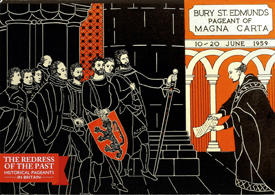- Home
- About Us
- The Great Charter
of Bury St Edmunds - The Magna Carta
- The Pageants
- Events
- Past Events
- Resources and Links
- Photo Gallery
- Rebecca’s Magna Carta Blog
Pageants Exhibition at Moyse’s Hall 4 May to 28 August 2015 FREE

Rebecca’s Magna Carta Blog Part 3 sub 1
Why Bury St Edmunds? Part 1 – the importance of Bury St Edmunds
Ok, so we’ve thought about why the Magna Carta is important and why it happened under King John’s reign. But why would the barons have met at Bury St Edmunds to agree on the terms prior to presenting their demands to King John?
This is part one which looks at the importance of Bury St Edmunds. Part two, looking at what made Bury St Edmunds an appealing option will follow shortly.
The town used to have a different name; Beodericsworth. In c.855 a new king came to the throne of the East Angles, his name was Edmund. In 869 a horde of Danes advanced on East Anglia. King Edmund refused to surrender his kingdom or give up his Christian faith so he was beaten, tied to a tree and shot full of arrows until he died and then beheaded. In c.903 his body was moved to the abbey in Beodericsworth, miracles were then reputed to have happened at the shrine erected for him. In c.925 the fame of the shrine had spread far and wide and the town was renamed Saint Edmund’s Bury.
In c.942 King Edmund I of England granted the abbot jurisdiction over the whole town; freedom from all secular services. In c.1028 King Cnut went further and freed the town from all other episcopal control. This made the abbot both God’s and the King’s representative in the abbey, town and all the lands connected to the abbey.
In 1071 Pope Alexander II published a papal bull putting Bury St Edmunds’ Abbey under the direct protection of the pope and ordering that no bishop’s see should ever be set up at Bury. Edward the Confessor issued a charter in 1044 that made the Liberty of St Edmunds exempt from all royal taxes and impositions; this made the abbot acted the king’s representative in this area which included the responsibility of arresting and holding criminals and rebels. The Liberty of Saint Edmund roughly equates to the area now known as West Suffolk, all of this was under the control of the abbot of Saint Edmundsbury.
St Edmund was a well respected Saint in 13th Century England, and was the patron saint of England at this time. The Abbey was one of the wealthiest and most powerful in the country and was often visited by English kings. Both Richard I and John visited the Abbey on more than one occasion. This is impressive for Richard as he spent only approximately 8 months of his ten year reign in England and shows how much he respected Saint Edmund.
When Richard I set sail on crusade in 1191 he went under the flags and protection of St Thomas, St Nicholas and St Edmund.
In 1199 King John visited the abbey shortly after his coronation. In March 1208 King John confiscated the property and revenues of the Abbey of St Edmund, along with those of his other ecclesiastical tenants, in retaliation against the papal interdict on England. In April the same year he restored all of the Abbey’s liberties, but not the revenues he had gained in that time.
On the 4th November 1214 King John visits the Abbey of Bury St Edmunds shortly after his return from an unsuccessful military campaign in France.
The abbey of Bury St Edmunds and the cathedral in Norwich were both being developed at similar times throughout the 11th and 12th centuries. Due to their close proximity they competed over size and style. The Abbey Church at Bury St Edmunds once completed was 6.8 metres longer than Norwich Cathedral and the West Front of the Abbey was unparalleled anywhere else in Britain at that time.
The abbey was also a significant landholder. In 1291 taxation records show that the abbey owned property in 126 parishes in Suffolk, 49 in Norfolk and others elsewhere in the country, including in London and the ancient port of Wainfleet in Lincolnshire.
All this demonstrates that in 1214 Bury St Edmunds and the Abbey at its centre where of great importance within the kingdom and not the remote rural market town that it is today. However it was not the only important, protected religious site in England and in the next blog I will look at what made Bury St Edmunds an even more ideal location for the meeting of the Barons.